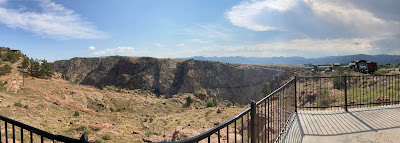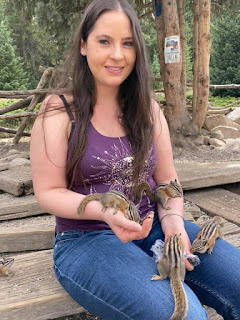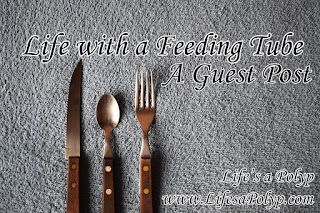It's been over a year since I took a real
vacation. I took a week off work at the end of 2019 to work on projects for my house, but that doesn't really count. I've been in need of a real vacation, particularly with the stress of Covid19. Work has changed with the pandemic resulting in extra responsibilities and increased exposure to others. I'm always mindful to wear all of my PPE to best protect myself and thus far haven't caught it myself.
Right before Covid19 hit the United States, I started a new relationship and this August we reached our 6 month anniversary. This may not seem like a big deal to many but it is for me. After a devastating
divorce in 2016, it hasn't been easy for me to find someone I feel as though I have a real chance for a lifetime commitment with.
We decided to drive to a cabin in the mountains, in the middle of a nature preserve, in Colorado to celebrate our relationship milestone.
Travel is not the easiest situation for someone like me who has
Short Bowel Syndrome (SBS). I don't let my health stop me from enjoying the activities I'm most interested in but that doesn't make participation in activities easy either. We would be driving for a full day with as minimal stops as possible in order to reach our cabin. This meant I would need to take the appropriate amount of Lomotil medication to slow by SBS and limit my food and fluid intake as well to help us minimize our stops for restroom breaks. However, I have to be careful with the amount of
Lomotil I take as it will cause me to have
intestinal blockages if I'm not careful and when traveling across the United States there are long distances without any facilities. And remember, we're in the middle of a pandemic and a toilet paper shortage. Not every business will allow non-customers to utilize their restrooms and not all businesses even admit to have a restroom. This not the best situation for anyone, especially for someone with gastrointestinal issues. We stocked up on toilet paper - I think we took about 25 rolls and an entire box of Calmoseptine ointment just to be on the safe side. I was over prepared but it's better to be safe than sorry.
The day we left for vacation was actually easier than the day we came back as my intestine was barely active resulting in a lack of appetite and thirst which helped reduce the number of stops we needed to take especially as there was about 2 hours of travel where there weren't any available stops. On our way back, I wasn't as fortunate although we managed fine. I took 5 Lomotil tablets on our way back but I was regularly hungry and thirsty. I was worried about the distance in between available stops so I frequently asked to stop - about every decent sized town that had a facility. I've also increased my water intake this year and so my body has become more accustomed to feeling thirsty and the need to urinate even if I haven't been drinking as much as I usually do anymore. Wearing a mask regularly when in public spaces to help prevent Covid19 transmission has also increased my thirst making it even harder to limit fluid intake. Any food or fluid intake and movement activates my SBS so any activity involving walking also increases my facility needs.
 |
Me and Mike
|
We finally reached our small cabin in the mountains and though we had some activities in mind, we didn't have much of an itinerary planned. It was more about relaxing away from home and work for us. The cabin belonged to the parents of my boyfriend's friend - who had just moved to a house within the same nature preserve a couple weeks earlier. We visited with his friend's parents often during our trip - enjoying meals and borrowed their off terrain utility vehicle to explore the nature preserve one day. I made sure to take a roll of toilet paper while off roading as the preserve was large and there were no public facilities. During our visit, we would see deer, big horned sheep, birds, eagles, rabbit, and even a bat that almost hit both of us in the face one night.
We decided to visit the nearest large town and enjoyed visiting its' local distillery, breweries, and winery as well as shopping at local shops before dining at a well known local pizzeria for dinner. We traveled to the Royal Gorge but decided not to cross the Gorge's bridge due to a steep admission price. We were able to enjoy the views from available overlooks.
 |
| Royal Gorge, Colorado |
 |
| Chipmunks in St. Elmo's |
We spent another day traveling the back dirt roads (which was a 2 hour trip, again no facilities available anywhere) to Mount Princeton in the San Isabel National Forest and driving to St. Elmo's - a ghost town in the national forest. There are still buildings to view in the ghost town and a small shop that remains open to visitors. There you can purchase seed to hand feed the local chipmunks at the Chipmunk Crossing. The chipmunks were very friendly, crawling all over us and into my purse even. The views and interacting with the chipmunks made this my favorite outing for the week.
I managed well during the day with our activities in spite of my SBS, however, the nights were a different story. Due to increased fluid intake and my Lomotil wearing off in the evenings, I required a significant increase in restroom breaks during the night. There was one day when I required to not take any Lomotil in order to allow my system to return to normal and prevent an intestinal blockage from occurring due to prolonged Lomotil use.
Overall, the vacation was a success and we thoroughly enjoyed ourselves. Colorado is a beautiful state and we were able to social distance from others easily to help reduce our risk of Covid19 exposure. If you're considering traveling during the pandemic, remember to be aware of any relevant state or local mandates of the areas you'll be visiting, bring a mask with you and plenty of your necessary medical supplies. I would also suggest toilet paper (you never know!) Consider traveling to less populated areas to reduce your risk of Covid19 exposure and avoid Covid19 hotspots. Each state of the US has a tourism website with great information about their local attractions and places of interest to help plan an interesting trip. Be safe out there!












